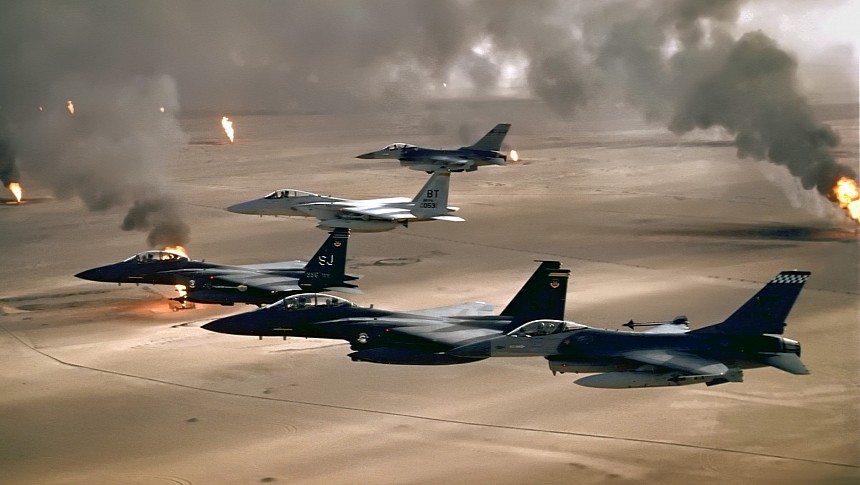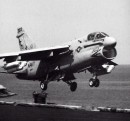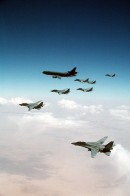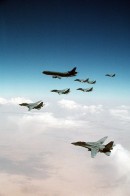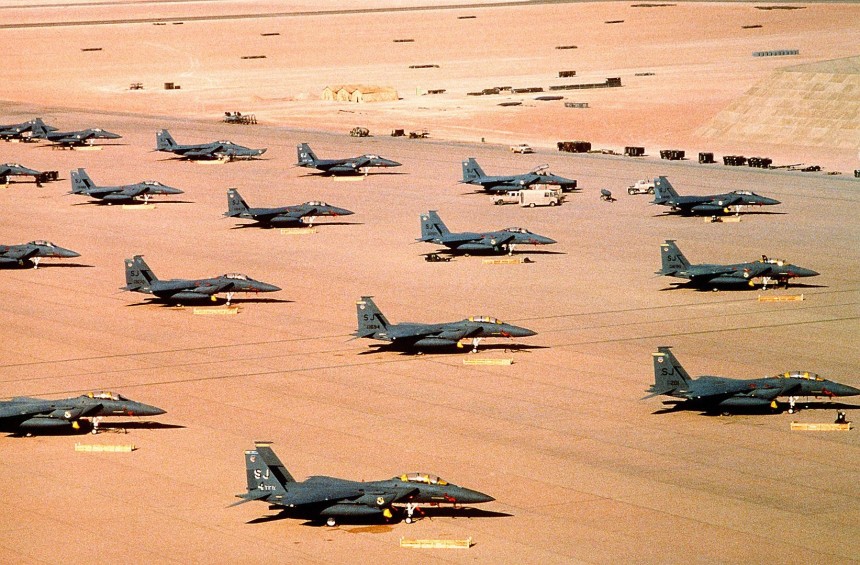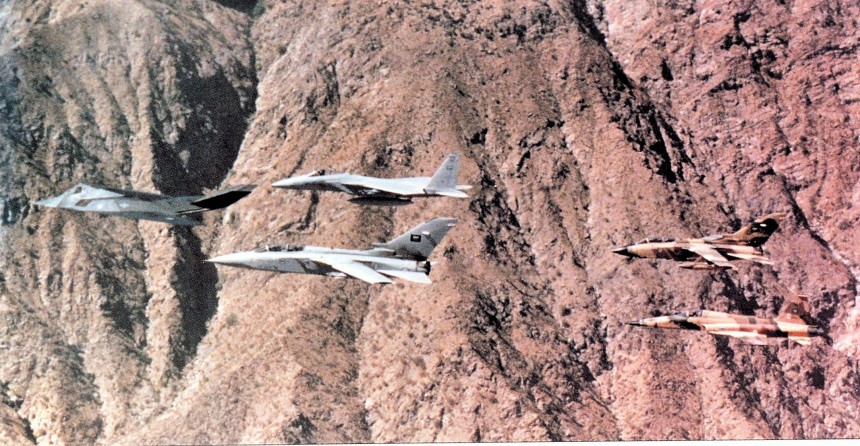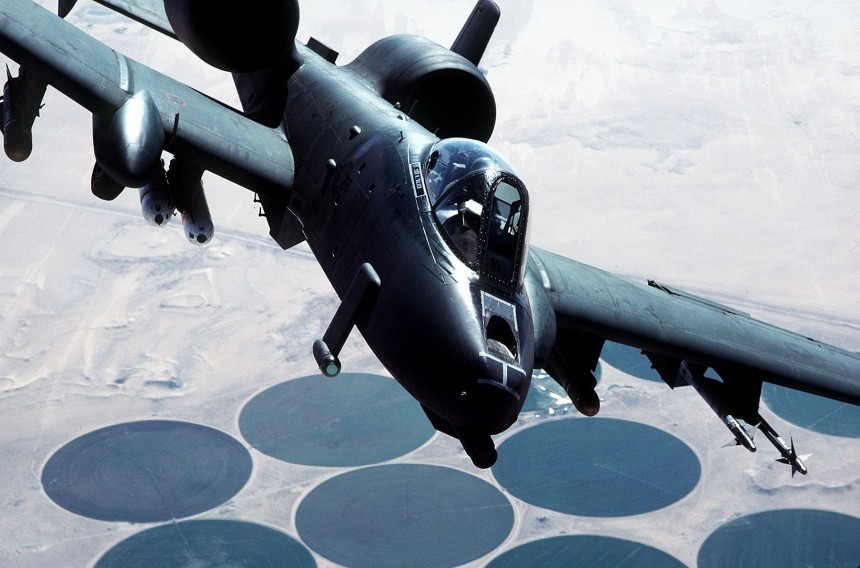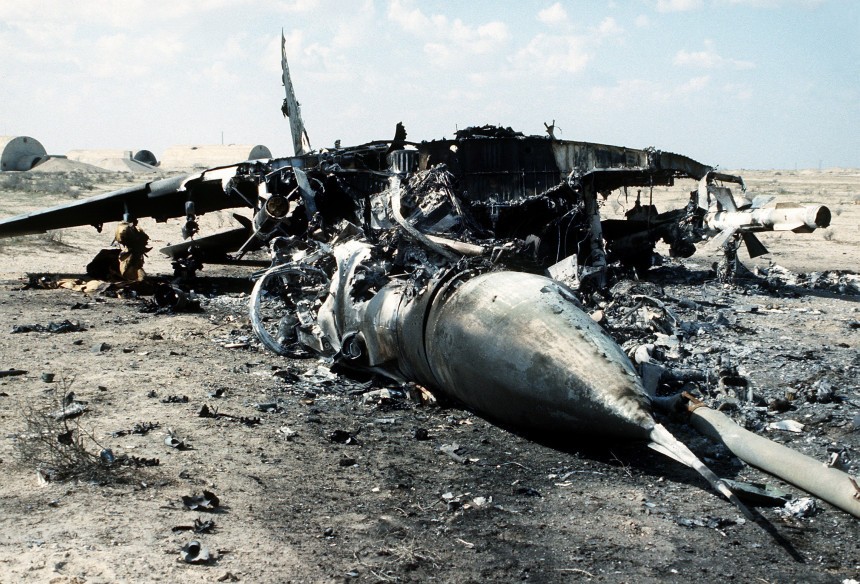Intriguing things happen when a country spends decades and trillions of dollars prepping for war with a peer-to-peer adversary, only to spend decades more fighting guerrilla insurgents on their home turf in the desert. This, in a nutshell, is the most glaring issue around military aviation today, perhaps even the entire military-industrial complex. All the cost overruns have to come from somewhere. But ten years before the disastrous War on Terror, a collection of NATO aircraft fought a more conventional war against a proper opposing air force. Suffice it to say, it was glorious.
This is the story of Operation Desert Storm, pound for pound the finest assembly of military aircraft since the dawn of flight. Such a sentiment might not jive with people who place Second World War aviation above all other eras of military aircraft. But in the sense that World War II warbirds were defined by a core nucleus of planes from each nation flanked by endless hoards of long-forgotten coattail riders, every Coalition jet that served in Desert Storm was an All-Star player, an all-time classic.
In some ways, this has more to do with Air Force doctrines changing since 1945. Jet fighters built after the early 1970s can famously do the jobs that multiple different aircraft would do collectively previously. But when you break down each jet piece by piece, you realize what NATO threw at the Iraqi Military was like the American Olympic Basketball Dream Team in the sky. But to understand how this ensemble cast of military planes came to be formed, we need to know at least a little bit about what caused Saddam Hussein to try and throw hands with the most powerful air force the world has ever seen.
Without explaining the entire history of Saddam's Ba'athist Party's rise to power and his allyship with the Soviet Union, it's safe to say Saddam was a thorn in NATO's backside far before the summer of 1990. On paper, Saddam's fighting forces were a formidable force. With veteran generals, field commanders, and, most importantly, pilots who'd cut their teeth in the Iran-Iraq War of 1980 to 1988, surrounding powers in the Middle East would be unwise to start a scrap with a tyrant as ruthless as Sadam at the helm.
With 47 infantry divisions at hand flanked by at least nine armored mechanized divisions supplied with Soviet T-55, T-62, and T-72 main battle tanks (MBTs), this alone would post a significant danger to Iraq's neighbors in the case they feel like scrapping over the region's vast oil reserves. But it was the Iraqi Air Force, stocked with icons of Soviet aviation with a spattering of old French and Chinese jets, that turned Saddam's Iraq into a teeth-chattering threat to its geographical neighborhood in the Persian Gulf.
Aircraft from Soviet Russia's most notable aerospace contractors, Sukhoi, Mikoyan, and Tupolev, had found their way into Iraqi hands in droves by the early 90s. Saddam's forces sported stalwarts of the Soviet Air Force like the MiG-19, MiG-21, and the more modern MiG-29, a top-of-the-line ground attack jet in the Su-25, and even the Mach 3-capable MiG-25 Foxbat interceptor. Rounding out the Iraqi Air Force were jets less well known in the West but no-less vital to Saddam, like Su-7 and Su-17/20 fighter bombers, Tupolev Tu-16 and Tu-22 heavy bombers, and even a few Chinese copycats in the form of the Shenyang J-6, Chengdu J-7, and the Xian H-6.
By comparison, Kuwait's Air Force of around 20 French Mirage F-1s, a couple of dozen American A-4 Skyhawks, and roughly a dozen English Electric Lightnings didn't stand a chance when Saddam finally blew his top on August 2, 1990. That very same day, the United Nations Security Council (UNSC) activated its proverbial trap card against Saddam with Resolution 660. Essentially, the act condemned Saddam's invasion of a sovereign neighbor as a war crime and gave the United States, its NATO Allies, and the entire consortium of UNSC coalition peace-keepers permission to prepare to intervene.
For better or, more often than not, for worse, Iraq would never be the same again after the first time it took Coalituin air power on the chin. The day after UMSC Resolution 660 was signed into law, U.S. Navy Aircraft Carriers were en route to the Persian Gulf. Four days later, a task force of 15,000 U.S. troops, 32 Navy destroyers, and 100 military aircraft and helicopters arrived in Saudi Arabia to commence Operation Desert Shield the next day, August 8th, 1990.
Though tensions would build over the course of the rest of 1990, the UNSC ultimately set an ultimatum for Saddam's regime with Resolution 678. the resolution's message was clear, stop defying the UNSC's demands and withdraw from Kuwait or its war. When the order once again fell on deaf ears, the time had finally come to boogaloo. At 2:38 in the morning on January 17th, 1991, a squadron of eight McDonnell Douglas AH-64 Apache attack helicopters flanked by four Sikorsky MH-53 Pave Low special-ops helicopters stormed over Iraqi radar sights near the Saudi Arabian border.
Before long that morning, 22 McDonnell Douglas F-15E Strike Eagles supported by one General Dynamics EF-111 Raven electronic warfare jet mercilessly pummeled Iraqi airfields while their jets were still on the ground. Freshly deployed from the prototype phase less than 12 months before Saddam's Invasion of Kuwait, Desert Storm was the Strike Eagle's first test in combat, one it passed with flying colors. Coalition aircraft were completing more than 1,000 sorties a day against Iraqi forces before long. These proved to be the operational debuts of not just the Strike Eagle but a whole host of other jets.
By 3 a.m. on the morning of the Coalition's counterattack against Iraq, the war saw its second big debut when ten Lockheed F-117 Nighthawk stealth fighter-bombers absolutely walloped Baghdad with a series of devasting bomb runs. Only when Iraqi anti-aircraft batteries heard the stealth fighter fly overhead did its battery of 3,000 anti-aircraft guns open fire on the strike force. It goes without saying no F-117s even got a scratch. Not long after, it was the Fairchild-Republic A-10 Thunderbolt II attack jet's turn to get its first taste of real warfare.
With a 30 mm Gau-8 Avenger for its main armament built for slicing up Soviet main battle tanks, the A-10 shined possibly like no other jet in the war. Its consortium of guided and unguided bombs, air-to-ground missiles, and rockets, besides its car-sized main gun, allowed the "Warthog" to cement its place in the hearts of aviation fans everywhere with its performance in the conflict. Estimates claim the A-10 knocked out as many as 987 Iraqi tanks, 926 artillery pieces, and over 1,300 combat vehicles during Desert Storm. Although more realistic estimates peg the number at around 300 and change.
Though the A-10 has its critics today, and rightly so, there's no doubt the Warhog's reputation was never stronger than in Desert Storm, and that's without mentioning the General Dynamics F-16 Fighting Falcon first stormed on the in Desert Storm to similar fanfare. At the same time, these prized, new warbirds are cutting their teeth on Iraqi ground targets; long-time workhorses of the Air Force like F-4G Phantom II and F-111 Aardvark in service since Vietnam provided deep-interdiction coverage against enemy ground elements.
Simultaneously, long-serving planes serving the UN Coalition, like the AC-130 Gunship and the B-52 Stratofortress strategic bomber, destroyed whatever Iraqi tanks the A-10s had left behind. All the while, Lockheed U-2 and TR-1A Dragon Lady reconnaissance planes that stretch their history back to the mid-1950s silently spied on Saddam's military installations and troop movements from north of 80,000 feet (24,000 m). Rumors persisted that the supersonic SR-71 Blackbird might have been involved in the conflict in some capacity. But officially, the Blackbird was retired mere months before the Invasion of Kuwait.
Through Heavyweights of pan-European air power like the Tornado F3 strike jet and the Tornado ADV Interceptor, the UN Coalition's air campaign was far from an all-American affair. French Sepecat Jaguars, Mirage F1Cs, F1CRs, and Mirage 2000Cs on the scene were another testament to this effect. At least 18 Canadian CF-18 Hornets and 12 Bahraini Air Force F-5 Freedom Fighters joined in alongside them in the near blitzkrieg levels of bombardment. While this was happening, coalition jets of all backgrounds were kept running by Boeing KC-135 Stratotankers and Handley Page Victor tanker aircraft that were as old as the hills.
Deploying alongside all their land-based Air Force comrades, Coalition Forces at sea aided in the aerial onslaught from the Persian Gulf. A total of six U.S. Navy aircraft carriers deployed during the Gulf War with the full weight of their F-18 Hornets, F-14 Tomcats, and A-6E TRAMS, ready to help shred whatever land-based Coalition Forces didn't destroy. Marine Corps AV8B Harriers derived from British Sea Harriers aided in this endeavor from land and sea. By the end of the Desert Storm campaign in February 1991, this all-time great consortium of Coalition aircraft downed 36 Iraqi jets and helicopters in air-to-air combat and 259 to SAM fire and on the ground.
Carcasses of destroyed Iraqi armored vehicles and aircraft littered its military bases and airfields for miles by the end of the fighting. A vengeful Saddam Hussein infamously blasted Kuwaiti oil pipelines on their retreat out of the country, nearly starting a global environmental catastrophe. In 42 days, the Middle East's pre-eminent air power was nothing more than a pile of scrap. With the exception of World War II, Desert Storm was unique in its complete and utter domination in the air by the victorious parties. But to fit it all into less than two months is an achievement unlikely to be matched again in warfare.
For this reason, Desert Storm will forever be particularly special to military aviation. Given time, we're sore that'll become self-evident. But for now, here's an awesome YouTube music video with some wicked shots from Desert Storm to the tune of Hairspray Hurricane by Carpenter Brut.
In some ways, this has more to do with Air Force doctrines changing since 1945. Jet fighters built after the early 1970s can famously do the jobs that multiple different aircraft would do collectively previously. But when you break down each jet piece by piece, you realize what NATO threw at the Iraqi Military was like the American Olympic Basketball Dream Team in the sky. But to understand how this ensemble cast of military planes came to be formed, we need to know at least a little bit about what caused Saddam Hussein to try and throw hands with the most powerful air force the world has ever seen.
Without explaining the entire history of Saddam's Ba'athist Party's rise to power and his allyship with the Soviet Union, it's safe to say Saddam was a thorn in NATO's backside far before the summer of 1990. On paper, Saddam's fighting forces were a formidable force. With veteran generals, field commanders, and, most importantly, pilots who'd cut their teeth in the Iran-Iraq War of 1980 to 1988, surrounding powers in the Middle East would be unwise to start a scrap with a tyrant as ruthless as Sadam at the helm.
With 47 infantry divisions at hand flanked by at least nine armored mechanized divisions supplied with Soviet T-55, T-62, and T-72 main battle tanks (MBTs), this alone would post a significant danger to Iraq's neighbors in the case they feel like scrapping over the region's vast oil reserves. But it was the Iraqi Air Force, stocked with icons of Soviet aviation with a spattering of old French and Chinese jets, that turned Saddam's Iraq into a teeth-chattering threat to its geographical neighborhood in the Persian Gulf.
By comparison, Kuwait's Air Force of around 20 French Mirage F-1s, a couple of dozen American A-4 Skyhawks, and roughly a dozen English Electric Lightnings didn't stand a chance when Saddam finally blew his top on August 2, 1990. That very same day, the United Nations Security Council (UNSC) activated its proverbial trap card against Saddam with Resolution 660. Essentially, the act condemned Saddam's invasion of a sovereign neighbor as a war crime and gave the United States, its NATO Allies, and the entire consortium of UNSC coalition peace-keepers permission to prepare to intervene.
For better or, more often than not, for worse, Iraq would never be the same again after the first time it took Coalituin air power on the chin. The day after UMSC Resolution 660 was signed into law, U.S. Navy Aircraft Carriers were en route to the Persian Gulf. Four days later, a task force of 15,000 U.S. troops, 32 Navy destroyers, and 100 military aircraft and helicopters arrived in Saudi Arabia to commence Operation Desert Shield the next day, August 8th, 1990.
Though tensions would build over the course of the rest of 1990, the UNSC ultimately set an ultimatum for Saddam's regime with Resolution 678. the resolution's message was clear, stop defying the UNSC's demands and withdraw from Kuwait or its war. When the order once again fell on deaf ears, the time had finally come to boogaloo. At 2:38 in the morning on January 17th, 1991, a squadron of eight McDonnell Douglas AH-64 Apache attack helicopters flanked by four Sikorsky MH-53 Pave Low special-ops helicopters stormed over Iraqi radar sights near the Saudi Arabian border.
By 3 a.m. on the morning of the Coalition's counterattack against Iraq, the war saw its second big debut when ten Lockheed F-117 Nighthawk stealth fighter-bombers absolutely walloped Baghdad with a series of devasting bomb runs. Only when Iraqi anti-aircraft batteries heard the stealth fighter fly overhead did its battery of 3,000 anti-aircraft guns open fire on the strike force. It goes without saying no F-117s even got a scratch. Not long after, it was the Fairchild-Republic A-10 Thunderbolt II attack jet's turn to get its first taste of real warfare.
With a 30 mm Gau-8 Avenger for its main armament built for slicing up Soviet main battle tanks, the A-10 shined possibly like no other jet in the war. Its consortium of guided and unguided bombs, air-to-ground missiles, and rockets, besides its car-sized main gun, allowed the "Warthog" to cement its place in the hearts of aviation fans everywhere with its performance in the conflict. Estimates claim the A-10 knocked out as many as 987 Iraqi tanks, 926 artillery pieces, and over 1,300 combat vehicles during Desert Storm. Although more realistic estimates peg the number at around 300 and change.
Though the A-10 has its critics today, and rightly so, there's no doubt the Warhog's reputation was never stronger than in Desert Storm, and that's without mentioning the General Dynamics F-16 Fighting Falcon first stormed on the in Desert Storm to similar fanfare. At the same time, these prized, new warbirds are cutting their teeth on Iraqi ground targets; long-time workhorses of the Air Force like F-4G Phantom II and F-111 Aardvark in service since Vietnam provided deep-interdiction coverage against enemy ground elements.
Through Heavyweights of pan-European air power like the Tornado F3 strike jet and the Tornado ADV Interceptor, the UN Coalition's air campaign was far from an all-American affair. French Sepecat Jaguars, Mirage F1Cs, F1CRs, and Mirage 2000Cs on the scene were another testament to this effect. At least 18 Canadian CF-18 Hornets and 12 Bahraini Air Force F-5 Freedom Fighters joined in alongside them in the near blitzkrieg levels of bombardment. While this was happening, coalition jets of all backgrounds were kept running by Boeing KC-135 Stratotankers and Handley Page Victor tanker aircraft that were as old as the hills.
Deploying alongside all their land-based Air Force comrades, Coalition Forces at sea aided in the aerial onslaught from the Persian Gulf. A total of six U.S. Navy aircraft carriers deployed during the Gulf War with the full weight of their F-18 Hornets, F-14 Tomcats, and A-6E TRAMS, ready to help shred whatever land-based Coalition Forces didn't destroy. Marine Corps AV8B Harriers derived from British Sea Harriers aided in this endeavor from land and sea. By the end of the Desert Storm campaign in February 1991, this all-time great consortium of Coalition aircraft downed 36 Iraqi jets and helicopters in air-to-air combat and 259 to SAM fire and on the ground.
Carcasses of destroyed Iraqi armored vehicles and aircraft littered its military bases and airfields for miles by the end of the fighting. A vengeful Saddam Hussein infamously blasted Kuwaiti oil pipelines on their retreat out of the country, nearly starting a global environmental catastrophe. In 42 days, the Middle East's pre-eminent air power was nothing more than a pile of scrap. With the exception of World War II, Desert Storm was unique in its complete and utter domination in the air by the victorious parties. But to fit it all into less than two months is an achievement unlikely to be matched again in warfare.
